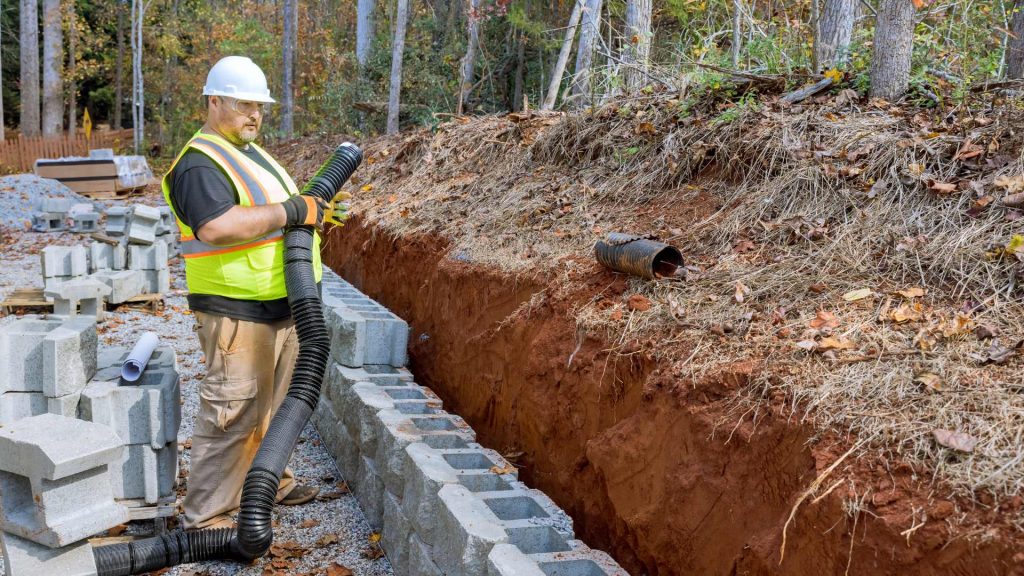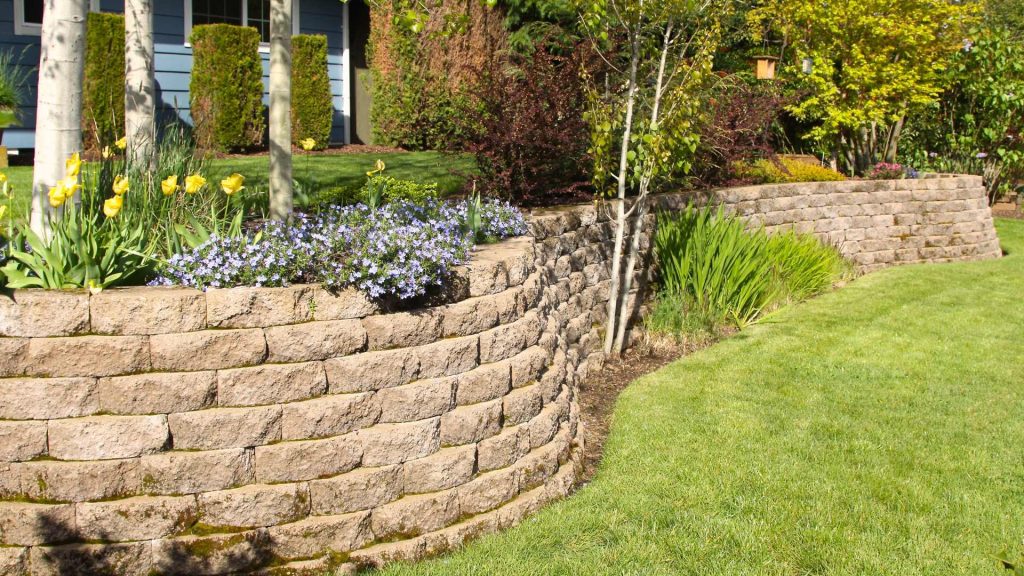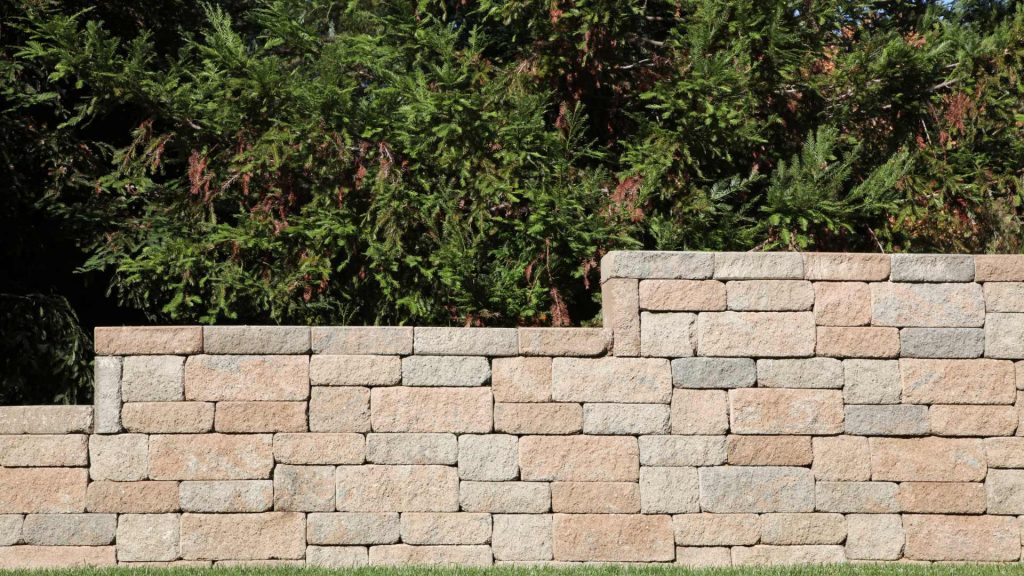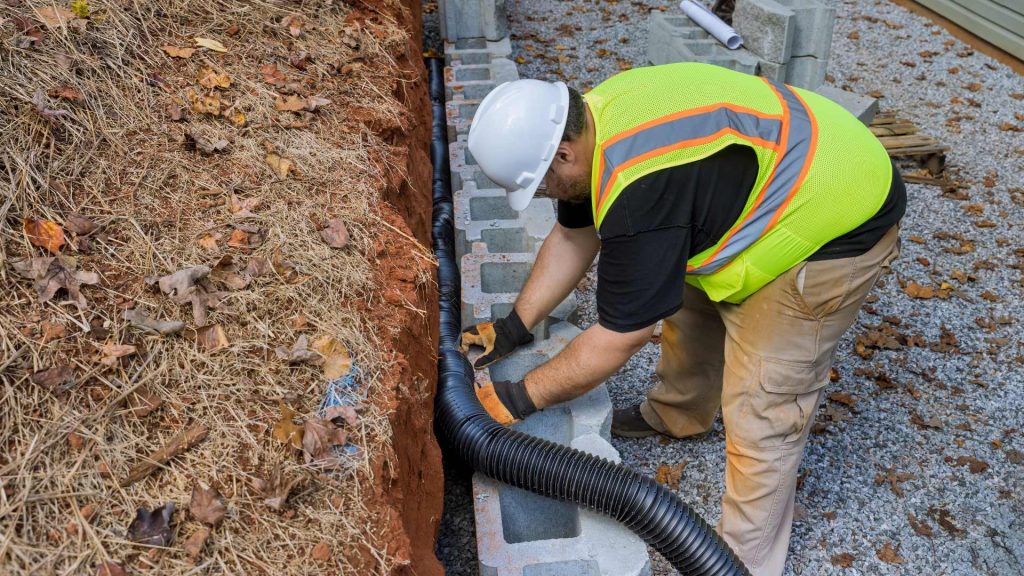Why Drainage Makes or Breaks Retaining Walls
Retaining walls don’t fail because the face cracks—they fail because water builds pressure behind them. In greater Collier County, you’re working with sandy soils, summer downpours, and a high water table near coastal neighborhoods. Without the right drainage, the backfill becomes a saturated sponge that pushes the wall forward or heaves the top course after a single storm. The good news: a well‑built wall with proper drainage is stable, long‑lived, and low‑maintenance—even through rainy season.
At Pavers of Naples, we install and repair segmental retaining walls (SRWs), natural stone garden walls, and masonry walls. This guide explains how we handle drainage in Park Shore, Pelican Bay, and Golden Gate Estates—and what permits you may need before you start.
Core Drainage Components
A reliable wall is a system, not just stacked blocks. The drainage package typically includes:
- Perforated Drain Pipe
A 4″ perforated SDR or corrugated pipe runs along the wall’s base on the heel side (behind the first course), wrapped or surrounded in clean stone. Pitch the pipe to a safe daylight outlet or a basin. Near tidal areas, add a check valve to prevent backflow during king tides. - Clean, Angular Backfill (No Fines)
3/4″ crushed stone (#57) to a depth of 12–18 inches from the wall back toward the slope. This stone column relieves water quickly. We do not use soil, pea gravel, or sand here—those trap water and migrate. - Filter Fabric (Separation Geotextile)
A non‑woven geotextile separates the crushed stone from native soils. It stops fines from washing into the stone, which would clog the drain over time. - Weep Path or Weep Holes
With SRW blocks, water exits through face joints as it percolates down to the drain. With solid face walls (masonry/poured), plan weep holes and a gravel core so water has a path out. - Free‑Draining Base & Batter
A compacted crushed‑stone base under the first course and a built‑in batter (setback) on the wall face improve stability and channel water down to the drain. - Geogrid (For Taller Walls or Surcharge Loads)
Horizontal layers of geogrid extend back into the soil mass, tying the retained soil to the wall like a reinforced beam. Grid length, spacing, and strength depend on wall height, soil, and loads.

Wall Types & How Drainage Differs
Segmental Retaining Walls (SRW Blocks)
- Best for: Most residential projects in Collier County up to engineered heights.
- Drainage: Stone backfill, 4″ perf pipe, geotextile separation, geogrid as required. Water escapes through joints; caps are adhered with flexible adhesive.
Natural Stone Garden Walls (Low)
- Best for: Decorative planters, step‑downs on grades, and short terraces.
- Drainage: Still use a stone backfill zone and fabric; for very low walls used as edging, the granular base may be sufficient if water can freely escape around ends.
Masonry/Poured Concrete Walls
- Best for: Tall walls near structures, seating walls integrated with lanais.
- Drainage: Critical to include weep holes and a gravel core connected to a drain line. Without weeps, hydrostatic pressure builds quickly in downpours.
Siting a Wall : Grades, Utilities, and Property Lines
- Slope & Swales: Maintain neighborhood swales and do not block water that historically flowed across your lot. Re‑create surface flow paths with shallow V‑swales or permeable bands above the wall.
- Utilities: Call 811 before digging. Expect irrigation lines and lighting conduits near driveways and paths.
- Setbacks & Easements: Keep walls off easements and property lines unless approved; drainage outlets can’t discharge onto neighbors.
- Roots & Planting: Large root zones (oaks, palms) can shift small walls; select root‑friendly layouts or use geogrid and deeper base.

Do You Need a Permit in Collier County?
Regulations change, but as a general rule of thumb across Florida municipalities:
- Height Thresholds: Walls above a certain height (commonly 3–4 feet) or any wall supporting a surcharge load (driveway, building, pool) typically require engineering and a permit.
- Location Sensitivity: Walls in or near flood hazard areas, right‑of‑way, waterfront, or coastal construction control zones may trigger additional reviews.
- HOA/ARC: Many communities in Park Shore, and Pelican Bay, require architectural review even for low walls.
What we recommend:
- Verify current requirements with Collier County Growth Management before design.
- If above the height threshold or supporting loads, get signed engineering with wall section details (grid length, embedment, backfill, drainage, global stability).
- Confirm daylight outlets are allowed and not discharging to neighbors or protected areas.
- Keep documents for inspections: site plan, section, material specs, grid certifications.
Step‑by‑Step: How We Build a Drainage‑Smart SRW
- Layout & Excavation
Mark the wall line; excavate for base, embedment (bury the first course), and the drain trench behind the heel. Over‑excavate for straight compactor access. - Base Preparation
Place compacted crushed stone in lifts to the specified thickness. Screed a bedding layer for a dead‑level first course—this controls the entire wall. - First Course & Leveling
Set the first course below finished grade for toe stability. Level front‑to‑back and side‑to‑side with a dead blow hammer; check every block. - Drain Pipe & Stone Backfill
Install a 4″ perforated drain, pitched to an approved outlet. Surround with clean stone; extend stone up 12–18 inches behind the wall. Place fabric between stone and native soils. - Geogrid Layers
At specified courses, lay geogrid perpendicular to the wall, extending back the engineered length. Tension the grid and stake before backfilling; never fold grid around corners without design guidance. - Backfill & Compact in Lifts
Backfill in 8–10 inch lifts, compacting each layer. Keep heavy compactors a safe distance from the wall face to avoid bulging. - Step‑Downs & Corners
On slopes, step the wall down to follow grade—don’t leave tall ends exposed. Tie inside/outside corners with manufacturer‑approved patterns. - Caps, Adhesive & Finish Grade
Adhere caps with flexible adhesive, not rigid mortar, so seasonal movement doesn’t crack the bond. Finish grading should push surface water away from the wall.

How Walls and Pavers Work Together
Many yards combine a retaining wall with a paver patio, pool deck, or driveway. To keep everything stable:
- Separate the Systems: Use a small relief joint and match elevations so pavers don’t trap water against the wall.
- Protect the Edge: Install concealed edge restraint at paver edges that meet the wall cap to avoid creep.
- Direct Weep Flow: Ensure water from the wall’s drain daylights away from paver joints; add a channel drain or permeable band if needed.
- Load Awareness: If a driveway bears on the retained soil, expect engineering and geogrid to handle surcharge.
Common Failure Modes (and Our Fixes)
- Bulging Middle Courses: Usually saturated backfill with no stone column. Fix: Excavate behind the wall, add stone, pipe, and fabric; re‑build with geogrid if height warrants.
- Leaning/Toppling: Inadequate embedment or base, sometimes tree root leverage. Fix: Rebuild from base, bury first course, add grid.
- Weep Stains/Efflorescence: Normal mineral leaching may show on solid walls. Fix: Design discreet weeps; clean with appropriate solutions; avoid sealing in trapped moisture.
- Clogged Outlets: Grass or mulch blocks the daylight outlet. Fix: Add a screen or discharge to a basin with grate.
Maintenance That Actually Matters
- Quarterly: Walk the wall after heavy rains. Verify outlets are clear and caps are secure; look for sinkholes at the top edge (sign of fine migration).
- Annually: Clear vegetation off the face, check for settlement, and flush outlets.
- After Storms: Inspect for scouring at ends; add stone aprons or adjust grade lines to re‑direct flows.
Cost Factors in Collier County
- Height & Length: Taller walls need more geogrid and engineering; step‑downs save cost and look better with gentle grades.
- Access & Haul‑Out: Tight alleys increase labor.
- Soils & Water Table: Saturated sands require thicker stone bases or temporary dewatering.
- Finishes: Split‑face block, natural stone veneers, and matching paver caps elevate the look and budget.
Real‑World Scenarios
- Park Shore Terrace: A 3‑foot SRW with 12–18 inches of stone backfill, geogrid at two courses, and a check‑valved outlet to a side yard basin. Result: no bulge after summer storms and dry paver joints.
- Golden Gate Estates Grade Cut: Long wall stepping down a driveway approach; permeable bands above the wall keep runoff from building pressure at the face.
- Planter Walls: Short natural stone planters rebuilt with fabric separation and hidden mini‑drains to stop soil from staining the face.
FAQs
Do all retaining walls need a drain pipe?
For walls that retain soil, yes in almost every case. Even in sandy soils, sudden downpours can saturate backfill. A perforated pipe in clean stone, pitched to daylight or a basin, is cheap insurance against hydrostatic pressure.
What is geogrid and when do I need it?
Geogrid is a high‑strength mesh that extends back into the slope and ties the soil mass to the wall. You need it for taller walls, sloped backfill, or any wall carrying a surcharge (driveway, structure, pool). Engineering determines grid strength, spacing, and embed length.
Will a short garden wall require a permit in Collier County?
Rules vary. Many jurisdictions allow very low decorative walls without a permit, but heights around 3–4 feet or any wall supporting loads commonly require permits and engineering. Always verify with Collier County Growth Management and your HOA before work begins.
Can I discharge the wall drain onto my neighbor’s property?
No. Outlets should daylight on your property into an approved area (swale, basin, or tie‑in) and not create nuisance flows. In coastal or tidal zones, add a check valve.
How do walls integrate with paver patios or driveways?
We keep the paver system independent: proper edge restraint, a small relief joint, and drains that move water away from the pavers. If the paved surface loads the wall, expect engineering and geogrid.
What causes most retaining wall failures ?
Blocked outlets, no fabric separator, or soil instead of stone behind the wall. The fix is to rebuild the drainage zone correctly and, if needed, add geogrid and embed the first course.
Final Take: Make Water Your Friend, Not Your Enemy
A retaining wall is only as strong as its drainage. Design a path for water, separate stone from soil with fabric, pitch a perforated pipe to a legal outlet, and reinforce taller walls with geogrid. Do those things—and secure permits when required—and your wall will look great and stay true through rainy season.

